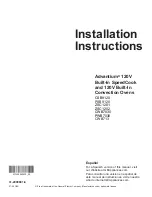
41
Dish size
Follow the dish sizes given in
the recipes, as these affect the
cooking and reheating times.
A quantity of food spread in a
bigger dish cooks and reheats
more quickly. Food cooks
better by microwave when in
a round container rather than
square.
Quantity
Small quantities cook faster
than large quantities, also small
meals will reheat more quickly
than large portions.
Spacing
Foods cook more quickly and
evenly if spaced apart. NEVER
pile foods on top of each other.
Shape
Even shapes cook evenly.
Whenever possible, cut the
vegetables and other foods in
regular pieces.
Density
Porous airy foods heat more
quickly than dense heavy
foods.
Covering
Cover foods with microwave
cling
fi
lm or a self-
fi
tting
lid. Cover
fi
sh, vegetables,
casseroles, soups. Do not
cover cakes, sauces, jacket
potatoes, pastry items.
Arranging
Individual foods e.g. chicken
portions or chops, should be
placed on a dish so that the
thicker parts are to the outside.
Starting temperature
The colder the food, the longer
it takes to heat up. Food from
a fridge takes longer to reheat
than food at room temperature.
Turning and stirring
Some foods require stirring
during cooking. Meat and
poultry should be turned after
half the cooking time.
Liquids
All liquids must be stirred
before, during and after
heating. Water especially must
be stirred before and during
heating, to avoid eruption.
Do not heat liquids that have
previously been boiled. DO
NOT OVERHEAT.
Ingredients
Foods containing fat, sugar or
salt heat up very quickly. The
fi
lling may be much hotter than
the pastry. Take care when
eating. Do not overheat even if
the pastry does not appear to
be very hot.
Cleaning
As microwaves work on food
particles, keep your oven clean
at all times. Stubborn spots of
food can be removed by using
a branded microwave spray
cleaner, sprayed onto a soft
cloth, always wipe the oven
dry after cleaning. Avoid any
plastic parts and door area.
General guidelines
F0003BM53BP.indd sec41
F0003BM53BP.indd sec41
2017/2/17 15:02:45
2017/2/17 15:02:45
















































